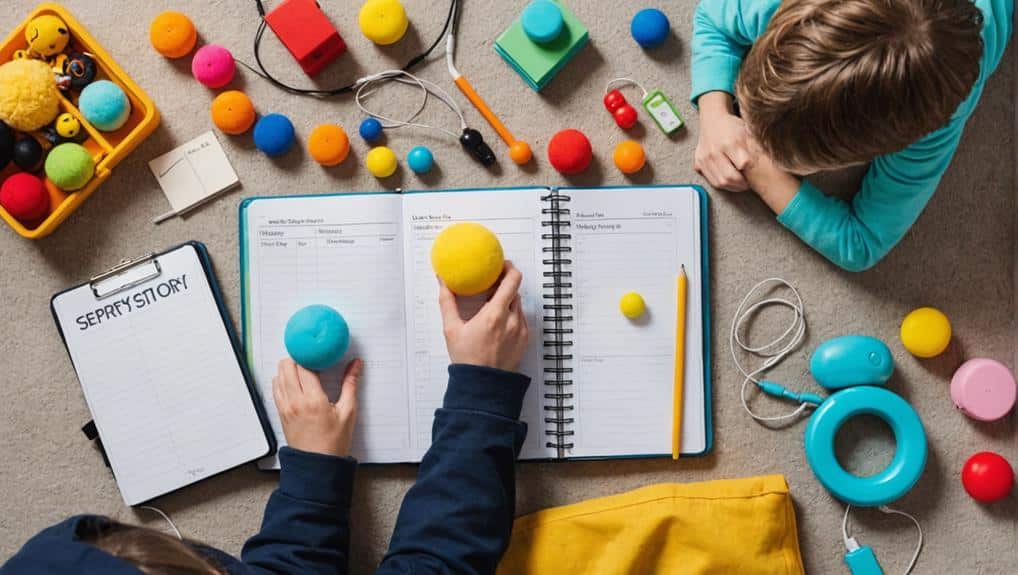Understanding sensory processing disorders (SPD) is essential because they make everyday activities difficult for those affected. Children with SPD might overreact to sounds, struggle with coordination, or show inconsistent responses to different sensory experiences. These signs are not always obvious, so it’s helpful for parents, teachers, and caregivers to know what to look for. Understanding sensory processing disorders allows you to spot these challenges early and get the right help.
Occupational therapy plays a crucial role in helping children manage SPD. Therapists create strategies to help children adapt to their sensory environment, improving coordination, focus, and comfort. Understanding sensory processing disorders and how therapy can help allows families and educators to support children better, helping them thrive daily.
Key Takeaways
- Sensory Processing Disorders occur when the nervous system improperly processes sensory inputs, causing a person to be overly sensitive or under-responsive to stimuli.
- Signs of SPD can include disproportionate reactions to stimuli, difficulty with coordination and balance, and challenges in social skills development.
- Early recognition of SPD signs enables prompt intervention with tailored treatment plans, improving the individual’s life and coping strategies.
- Occupational therapists play a crucial role in managing SPD. They use standardized assessments to diagnose and create personalized sensory diets for treatment.
- Sensory-friendly environments, regular sensory breaks, and sensory integration therapy are effective occupational therapy interventions for managing SPD.
Defining Sensory Processing Disorders
Sensory processing disorders (SPD) can be likened to puzzling language that a child’s brain can interpret correctly. This difficulty in processing sensory information can significantly impact a child’s daily zoning and overall quality of life. The disorder affects how the nervous system processes sensory information, resulting in symptoms that vary from child to child, including hypersensitivity or hyposensitivity to sensory stimuli. Early intervention is essential in managing these sensory challenges.
Children with SPD grapple with sensory input from all five primary senses—sight, sound, touch, taste, and smell—and lesser-known senses such as proprioception (body awareness) and interoception (internal physiological sensations). The symptoms can manifest in various behaviors, from emotional regulation issues to sensory-seeking or sensory-avoiding behaviors. Uncommon behaviors such as avoiding eye contact may signal SPD in infants.
Occupational therapy plays a pivotal role in helping children with SPD by providing them with coping strategies and methods to improve their sensory processing skills. Through this therapeutic approach, therapies like sensory integration therapy are often recommended. Children can learn to navigate their sensory experiences more effectively, helping them to engage more comfortably with their environment. Understanding SPD and seeking appropriate support is crucial in helping these children reach their full potential.
Common Signs of SPD in Children
Recognizing the symptoms of Sensory Processing Disorder in children is the initial step to seeking assistance. When a child has sensory processing difficulties, their reactions to everyday stimuli can seem out of proportion. For instance, they may recoil at loud noises, overreacting to sounds most individuals find tolerable. Another sign is unresponsiveness or under-responsiveness to physical stimuli like heat, cold, or pain. Children with SPD might also exhibit coordination and balance challenges due to the involvement of the vestibular system, which is often affected in SPD.
These sensory challenges often interfere with the development of social skills, making it vital to recognize the signs of SPD early on. Children with SPD may struggle in social contexts, as their sensory experiences can be overwhelming or confusing.
Early intervention is recommended for a child with SPD, primarily through pediatric therapy. Occupational therapists, experts in SPD, can equip these children with coping strategies, improving their social interactions and reducing the impact of sensory challenges on their day-to-day activities. This support from occupational therapy enriches the child’s auditory sensory input and helps them navigate their world with more confidence and fewer challenges.
Understanding Hypersensitivity and Hyposensitivity
Understanding the nuances of hypersensitivity and hyposensitivity is essential in the context of sensory processing disorders. Hypersensitivity involves an exaggerated response to sensory input, resulting in over-responsiveness. This can lead to significant discomfort for children, as they may exhibit extreme reactions to loud noises, bright lights, or certain textures due to heightened sensitivity. In contrast, therapy for Sensory Processing Disorder (SPD) can help regulate these responses to sensory input. With the help of tailored sensory activities, children can learn to process sensory information more effectively. Empathy and patience become critical in managing these intense sensory experiences.
Conversely, hyposensitivity refers to reduced sensitivity to sensory input. Children with hyposensitivity often seek out intense sensory experiences to feel stimulation. This could manifest as high-risk behaviors or an indifference to pain or temperature changes. Understanding these variances between hypersensitivity and hyposensitivity is crucial for effectively serving children with sensory processing disorders.
Recognizing these differences is vital for parents and caregivers and essential for occupational therapy professionals. Tailoring interventions and support specifically to hypersensitivity or hyposensitivity can make a significant difference in managing sensory processing disorders, providing these children a better quality of life. Remember, understanding is the initial step towards practical help and support.
Role of Occupational Therapy in SPD
Moving from identifying hypersensitivity and hyposensitivity, it is equally important to highlight the role occupational therapy plays in managing Sensory Processing Disorder (SPD). Occupational therapists not only recognize the signs and symptoms of SPD in young children but also use formal diagnostic tools like standardized assessments and parent interviews for an accurate diagnosis. As a cornerstone of support for children with SPD, occupational therapy provides the necessary tools to navigate sensory challenges. Central to this is creating personalized treatment plans, including selecting sensory activities and using specific equipment. These plans, tailored to each child’s sensory child’s needs, are the foundation of the therapeutic process.
Occupational therapy employs sensory-rich activities to help children process sensory input in a controlled, safe environment. These activities are essential to sensory integration therapy, a technique that helps children understand and respond to sensory stimuli. By practicing these activities, children with SPD can gradually improve their sensory processing abilities and develop coping strategies that aid daily functioning.
The significance of early intervention through occupational therapy cannot be overstressed. With professional and empathetic support, children can make significant strides in managing sensory challenges, thus enhancing their quality of life and overall well-being. Therefore, occupational therapy is paramount in addressing and managing SPD effectively.
Sensory Diets: Tailored Interventions

Shifting our focus onto “Sensory Diets: Tailored Interventions,” we must note the”crucial role these personalized plans play in managing Sensory Processing Disorder (SPD). Sensory diets, crafted by occupational therapists, are customized intervention strategies designed to address specific sensory processing challenges. These plans comprise a range of activities, exercises, and methods fully tailored to an individual’s sense of individual preferences. In alignment with pediatric occupational therapy, sensory diets also incorporate sensory integration techniques to foster motor skill development and adaptive responses to sensory input.
Sensory diets regulate sensory input and can significantly enhance attention, behavior, and emotional regulation, offering a suitable platform for individuals with SPD to function effectively. Whether implemented at home, school, or in therapy settings, sensory diets are versatile and adaptable, making them a feasible option for consistent sensory input regulation.
Managing SPD through sensory diets is not something done alone. It takes teamwork between therapists, caregivers, and educators. Understanding the child’s needs and using strategies consistently across all settings makes the intervention more effective. Sensory diets provide a personalized approach, serving as a helpful tool for managing sensory processing disorders.
Creating a Sensory-Friendly Environment
While sensory diets offer a personalized approach to managing Sensory Processing Disorders, it is just as vital to consider the broader environment in which these individuals operate. Creating a sensory-friendly setting can significantly improve their daily living experiences. A sensory-friendly setting minimizes noise, offers calming spaces, and uses gentle lighting to lessen sensory overload.
To assist individuals in coping better, sensory tools like weighted blankets, fidget toys, and sensory bins should be considered. These tools provide a comforting effect and help handle sensory challenges. Moreover, organizing spaces with clear boundaries and visual schedules can encourage a sense of predictability and security.
Additionally, strategies like sensory breaks and movement breaks can regulate sensory input, offering relief. Deep-pressure activities can also be helpful. Tailoring the environment to personal preferences, such as adjusting lighting, temperature, and textures, can improve comfort and reduce sensory distress.
Creating a sensory-friendly environment involves thoughtful planning and continuous adjustments to meet personal needs. Through these efforts, we can provide a welcoming, calming space for those managing Sensory Processing Disorders.
Importance of Early Intervention

Early intervention can significantly improve a child with Sensory Processing Disorders (SPD). Recognizing the signs of SPD as soon as possible allows for prompt intervention and the creation of tailored treatment plans. Such early action can alter a child’s life trajectory, helping them develop coping strategies and significantly enhancing their quality of life.
Occupational therapy plays a central role in this process, providing the needed support for children struggling with SPD. This therapy aids children in interpreting and responding appropriately to sensory information, an important developmental step. Moreover, introducing children to sensory-friendly activities can also offer significant benefits. Such activities provide a safe and comfortable environment for children with SPD and support their overall growth.
Navigating Life With Sensory Processing Disorders
Exploring life with Sensory Processing Disorders presents distinctive challenges and demands comprehension from caregivers and educators. Identifying sensory over-reactivity, such as heightened responses to stimuli, is crucial in pinpointing SPD. Successful occupational therapy interventions can significantly improve the child’s capacity for sensory inputs, enhancing their quality of life.
Recognizing Sensory Over-Responsivity
Life’s sensorLife’s endoscope can become overwhelming for people with Sensory Overresponsivity (SOR), a prevalent subtype of Sensory Processing Disorders (SPD). These individuals are hypersensitive to sensory inputs, overreacting to stimuli most people easily tolerate. This heightened response can manifest in diverse ways, leading to significant feelings and behavioral reactions.
Recognizing SOR involves understanding four key characteristics:
- Intense Reactions: People with SOR may react strongly to loud noises, bright lights, or specific textures, which can disrupt daily activities.
- Avoidance Behavior: They often avoid specific sensory experiences, such as crowded places or tactile stimuli, to manage their heightened responses.
- Feelings Responses: SOR can trigger heightened feelings responses, including anxiety, irritability, or mood swings.
- Regulation Difficulty: People with SOR struggle to regulate sensory inputs, which leads to challenges in social participation and daily functioning.
Understanding these signs is the initial step toward providing tailored interventions. Through coping strategies, individuals can learn to regulate sensory responses. Environmental modifications can also support those with hypersensitivity, creating a more comfortable, manageable environment. We can help people with SOR navigate their sensory world more easily through compassion, understanding, and effective interventions.
Effective Occupational Therapy Interventions
After recognizing the signs of Sensory Over-Responsivity, the next step is investigating therapeutic interventions. Occupational therapy interventions are particularly effective for managing sensory processing disorders. These interventions focus on helping children process sensory input more effectively, improve body awareness, and enhance motor skills.
Occupational therapists create tailored treatment plans adapted to each child’s needs. A child’s treatment plans include sensory diets and specially designed activities that help regulate a child’s senses. Sensory diets can significantly improve a child’s ability to investigate daily activities.
Moreover, creating sensory-friendly environments can be beneficial. These are spaces where sensory input is controlled, offering a place of refuge and comfort for children with sensory processing disorders. Sensory breaks and short rest periods from sensory stimulation can also be included in daily routines to manage over-responsivity.
Early intervention with occupational therapy can significantly improve a child’s quality of life functioning. Therefore, seeking professional help is necessary for children with sensory processing disorders. These children can comfortably navigate their sensory world with the right support strategies.
Frequently Asked Questions
How Does an OT Diagnose Sensory Processing Disorder?
An occupational therapist diagnoses Sensory Processing Disorder by conducting detailed evaluations of a child’s sensory responsibilities using standardized tools and observations in different environments. The therapist collaborates with caregivers for a thorough assessment.
How Can Occupational Therapy Help With Sensory Processing?
Occupational therapy assists children with sensory processing disorders by enhancing their sensory processing abilities and motor skills. It provides tailored treatment plans and sensory-friendly environments, fostering coping mechanisms for sensory overload.
What Are Sensory-Based Interventions for Occupational Therapists?
Sensory-based interventions are therapeutic strategies occupational therapists use to help children with sensory processing disorders effectively process and respond to sensory information, promoting improved daily functioning and self-regulation.
What Is a Sensory Seeker in Occupational Therapy?
A sensory seeker in occupational therapy is a child who craves sensory stimulation. They engage in activities like spinning or jumping, seeking textures to fulfill their sensory needs and aid nervous system regulation.
Conclusion
A thorough understanding of Sensory Processing Disorders (SPD) makes it possible to identify the signs early and seek appropriate occupational therapy support. Tailored interventions and sensory-friendly environments can significantly improve sensory processing and general quality of life. Early intervention is crucial in managing SPD effectively, emphasizing the importance of awareness, timely diagnosis, and professional assistance. Ongoing research and comprehension of SPD will further enrich the support systems available for individuals facing these challenges.


Recent Comments